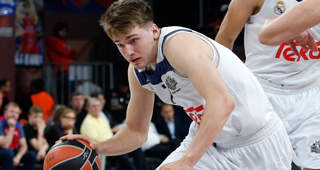Luka Doncic continues to build on what has to be the most remarkable résumé for a teenage basketball phenom.
Slovenia won the 2017 Eurobasket last month and the 18-year-old [1] was not only a rotation player in this winning run, leading the squad in minutes, which alone would be very impressive for someone his age, but was in fact a key reason why such an accomplishment was possible to begin with, ranking third on the team in plus-minus – according to FIBA.com.
Igor Kokoskov organized the team very well, with Goran Dragic taking priority running high pick-and-roll and attacking off curls around pindown screens at the elbow, logging a 33.2% usage-rate – according to our stats’ database.
With that as the case, Doncic was for the most part a secondary ball handler.
He still had plenty of opportunities to push the ball in transition, given he is such a great defensive rebounder, and run pick-and-roll against a set defense, with and without Dragic on the floor. In those instances, the six-foot-eight maestro showcased once more his court vision is amazing.
Doncic can not only anticipate passing lanes a split-second before they come open but also make shooters on the opposite end of the floor open; working his man into the screen, getting him on his back and manipulating the help with hang dribbles and hesitation moves, playing at a pace that is impressive when you get to see guys like Dragic and Bogdan Bogdanovic do so, let alone an 18-year-old.
Opponents forced his hand during this tournament, though. Doncic saw a lot of teams going out of their way to guard pick-and-rolls two-on-two, while others like Greece and Latvia felt comfortable switching behemoths such as Ioannis Bourousis and Kristaps Porzingis onto him from time-to-time.
With that as the case, Doncic assisted on just 20.6% of Slovenia’s scores when he was on the floor, which is a good percentage, but one that is below what we’ve come to expect from him. Though on a good note, it limited his exposure to risk and kept his turnover problem under control, as he turned it over just 12 times in 262 minutes.
Earlier in the tournament, he was given space to pull-up from three-point range off the pick-and-roll often and proved he is capable of making enough shots to discourage the opponent from going under picks and dropping the big man way back consistently. His release on such uncontested dribble-in pull-ups looked quite fluid and he hit a few shots from NBA distance.
Later in the tournament, defenders played up on him, both in the pick-and-roll with big men showing higher as he goes around the screen and in isolation. Doncic has an advanced handle to maneuver his way around traffic but doesn’t have enough quickness to just lose his man on hesitate-and-go’s, so he didn’t get all the way to the rim a whole lot in this event, taking just 17 of his 101 field goal attempts in the restricted area – based on the shotcharts available at FIBA.com.
But Doncic is pretty big, able to maintain his balance and his momentum forward through contact, and can still put a good deal of pressure at the last line of defense even if he is not attacking the basket furiously. He once again proved himself a very resourceful finisher from the in-between area, nailing 18 of his 30 shots in the lane, and averaged five free throws per 40 minutes.
When opponents were able to bottle him in the mid-range, Doncic leaned on step-back and stop-and-pop pull-ups that went in at a 4-for-10 clip. Much like his three-point jumper, he can make these shots when the big man lets him rise uncontested but hasn’t shown to be an aggressive enough shooter to make this not the shot that the defense is willing to give up to him.
He finished just 21.8% of Slovenia’s possessions with a shot, foul shot or turnover when he was on the floor, though. With Dragic leading the way, Doncic had to operate as a floor-spacer and ball mover a lot of the time. His catch-and-shoot three-pointer looked pretty good more often than not, as he does great shot prep, rises up in balance and launches it comfortably.
But the ball continued to go in at a below average clip. Doncic can certainly nail open shots but struggles when he is forced to speed up his release, both with a hand in his face on effective closeouts and when he is asked to sprint to the ball, come off screens or relocate. Overall, he hit just 31.1% of his 61 three-point attempts, also due to some poor shot selection on pull-ups.
Defensively, the picture is becoming clearer.
While Doncic can run point on offense full-time thanks to his remarkable dexterity operating in pick-and-roll, he is not suited to defend the point of attack on the other end. Doncic is too big to go over picks consistently and often compromised the integrity of the scheme behind him when the opponent ran him into a ball-screen. Smaller guards can also just blow by him out in space.
But as a weak-side defender, Doncic might develop into a difference maker, despite the fact he doesn’t create a lot of events, other than helping clean up the defensive glass, which he was exceptional at, collecting 28.3% of opponents’ misses when he was on the floor, which ranked 14th in the tournament – according to our stats’ database.
By simply being intelligent and disciplined executing the scheme consistently, helping crowd the area near the basket and rotating in as the last line defense to contest shots at the rim with verticality, and then finishing possessions securing the defensive rebound, Doncic ranked second on the team in defensive rating, behind Anthony Randolph.
[1] Who only turns 19 in February



